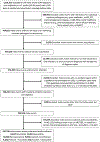Comparative safety of different antibiotic regimens for the treatment of outpatient community-acquired pneumonia among otherwise healthy adults
- PMID: 39442057
- PMCID: PMC12355227
- DOI: 10.1093/cid/ciae519
Comparative safety of different antibiotic regimens for the treatment of outpatient community-acquired pneumonia among otherwise healthy adults
Abstract
Background: Evidence is limited about the comparative safety of antibiotic regimens for treatment of community-acquired pneumonia (CAP). We compared the risk of adverse drug events (ADEs) associated with antibiotic regimens for CAP treatment among otherwise healthy, non-elderly adults.
Methods: We conducted an active comparator new-user cohort study (2007-2019) of commercially-insured adults 18-64 years diagnosed with outpatient CAP, evaluated via chest x-ray, and dispensed a same-day CAP-related oral antibiotic regimen. ADE follow-up duration ranged from 2-90 days (e.g., renal failure [14 days]). We estimated risk differences [RD] per 1000 treatment episodes and risk ratios using propensity score weighted Kaplan-Meier functions. Ankle/knee sprain and influenza vaccination were considered as negative control outcomes.
Results: Of 145 137 otherwise healthy CAP patients without comorbidities, 52% received narrow-spectrum regimens (44% macrolide, 8% doxycycline) and 48% received broad-spectrum regimens (39% fluoroquinolone, 7% β-lactam, 3% β-lactam + macrolide). Compared with macrolide monotherapy, each broad-spectrum antibiotic regimen was associated with increased risk of several ADEs (eg, β-lactam: nausea/vomiting/abdominal pain [RD per 1000, 3.20; 95% CI, 0.99–5.73]; non–Clostridioides difficile diarrhea [RD per 1000, 4.61; 95% CI, 2.47–6.82]; vulvovaginal candidiasis/vaginitis [RD per 1000, 3.57; 95% CI, 0.87, 6.88]). Narrow-spectrum antibiotic regimens largely conferred similar risk of ADEs. We generally observed similar risks of each negative control outcome, indicating minimal confounding.
Conclusions: Broad-spectrum antibiotics were associated with increased risk of ADEs among otherwise healthy adults treated for CAP in the outpatient setting. Antimicrobial stewardship is needed to promote judicious use of broad-spectrum antibiotics and ultimately decrease antibiotic-related ADEs.
Keywords: Community-acquired pneumonia; administrative data; adverse drug events; antibiotic safety; antimicrobial stewardship.
© The Author(s) 2024. Published by Oxford University Press on behalf of Infectious Diseases Society of America. All rights reserved. For commercial re-use, please contact reprints@oup.com for reprints and translation rights for reprints. All other permissions can be obtained through our RightsLink service via the Permissions link on the article page on our site—for further information please contact journals.permissions@oup.com.
Conflict of interest statement
All authors have submitted the ICMJE Form for Disclosure of Potential Conflicts of Interest. Conflicts that the editors consider relevant to the content of the manuscript have been disclosed.
Figures




References
-
- Fleming-Dutra KE, Hersh AL, Shapiro DJ, et al. Prevalence of inappropriate antibiotic prescriptions among US ambulatory care visits, 2010–2011. JAMA 2016;315:1864–73. - PubMed
-
- Bjerre LM, Verheij TJ, Kochen MM. Antibiotics for community acquired pneumonia in adult outpatients. Cochrane Database Syst Rev 2009;CD002109. - PubMed
-
- Maimon N, Nopmaneejumruslers C, Marras TK. Antibacterial class is not obviously important in outpatient pneumonia: a meta-analysis. Eur Respir J 2008;31:1068–76. - PubMed
Grants and funding
LinkOut - more resources
Full Text Sources
Miscellaneous

